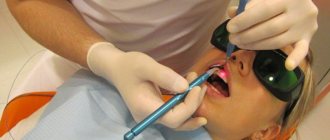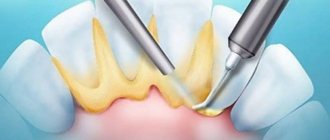- What is this
- Kinds
- Causes
- Consequences
- Treatment
- Prevention
Plaque accumulates on the teeth due to insufficient oral hygiene, which hardens over time. This is how tartar forms, which causes a lot of trouble. It not only spoils the appearance of teeth, creates bad breath, but also leads to serious diseases. We will tell you clearly about why it is dangerous, what it looks like, how to deal with it and what is the prevention of its occurrence.
What it is
Tartar is a hardened plaque that forms in adults and very rarely in children, and even then in the presence of a history of serious diseases such as heart disease or diabetes. Usually, if you spend enough time on hygienic procedures to remove plaque, stones will not form on your teeth. If plaque is not allowed to harden, stones cannot form. Therefore, thorough brushing of teeth is the best means of prevention.
Tartar can occur on one single tooth or on several teeth. The lower front teeth, as well as the upper and lower molars, are most susceptible to tartar formation.
Signs:
- Tartar causes bad breath;
- gums begin to itch and bleed;
- Dark stains appear on the visible surfaces of the teeth that cannot be removed with a brush.
Tartar can form not only on enamel, but also on crowns or dentures. Therefore, those who do not have their own teeth in their mouth, but only dentures, should not relax - stone can form on them, just like on the surface of the enamel. It, of course, will not lead to caries on the crown, but it can provoke inflammation of the gums, and also significantly spoil the appearance of the dentures.
Plaque from tea and cigarettes can provoke the formation of tartar. The constant presence of such plaque on hard-to-reach enamel surfaces inevitably leads over time to the formation of dense deposits, including stones.
Air Flow technology: softer than ultrasound
The technology involves cleaning the dentition (soft and hard deposits) using a water-air jet based on baking soda (sodium bicarbonate). The combination of properties such as the solubility and abrasiveness of sodium bicarbonate makes cleaning very effective, and flavoring agents are added to the mixture to minimize patient discomfort.
The Air Flow method is particularly gentle on the enamel and has a visible result. The cleaning process involves exposing the teeth to a jet under strong pressure at an angle of 30°, during which plaque (not stone) is softened and removed! The dentist’s task is not to touch open areas of dentin and gums during the procedure.
After cleaning using the Air Flow method, smoking and eating/alcohol consumption is prohibited (from 3 to 6 hours).
Air Flow technology is indicated for use in the following cases:
- for cleaning implants, metal-free ceramic structures, ceramic veneers;
- before filling or implantation, during dental restoration;
- if necessary, mineralize tooth enamel (fluoridation);
- for cleaning the bracket system.
Cleaning using this technology involves removing a protective organic film, which temporarily makes the teeth very sensitive. Therefore, it is recommended to use mouth rinses and replace your toothbrush.
Kinds
There are two types of tartar, depending on its location - subgingival and supragingival.
Subgingival tartar can only be detected by a dentist using a special probe, since it is hidden from view by the edge of the gum. It is located in the periodontal pocket and fits tightly to the root. The color of this stone is usually dark brown or greenish-black, it is extremely hard and consists mainly of calcium phosphate, magnesium phosphate and calcium carbonate. If subgingival stone is not removed in a timely manner, it can provoke an inflammatory process in the periodontium and cause periodontitis.
Supragingival tartar can be diagnosed independently; it stands out on the surface of the enamel with its yellowish or brownish color and is easily removed using a dental excavator. It is usually located above the crest of the gingival margin, so it is easy to recognize. In terms of density, supragingival stone is much softer than subgingival stone, since it is a salivary type formation and consists mainly of epithelial cells, bacteria, mucus and food debris. If it is not removed in a timely manner, over time the hardened plaque turns into caries.
Causes
If you have stones, the reason for their occurrence may be the following:
- lack of systematic oral hygiene;
- use of low-quality accessories for brushing teeth;
- the presence of a large amount of dental plaque;
- violation of salt metabolism;
- increased viscosity of saliva, as a result of which it loses its cleansing properties and does not wash away plaque;
- insufficient consumption of solid foods, which promote self-cleaning;
- unilateral chewing of food (only on the left or only on the right side of the jaw) as a result of the presence of diseased or missing teeth in the patient’s mouth;
- increased roughness of the enamel surface as a result of filling or orthodontic treatment;
- smoking.
Why is tartar dangerous?
The formation of dental plaque, and then tartar, is possible for various reasons: the involvement of only one side of the jaw, left or right, in chewing; dietary habits, in particular, eating only soft foods; salt imbalance in the body; using low-quality toothbrushes; crooked teeth; smoking. And some people have a congenital predisposition to the appearance of stones. In such cases, even regular care does not guarantee the safety of teeth.
Microbes, which make up 95% of plaque, form acid during their life processes, which, due to tartar, cannot be neutralized by the alkaline environment of the oral cavity. As a result, the enamel is gradually destroyed, and a favorable environment for the formation of caries is formed. Tartar also negatively affects the gums - located between the gum and the tooth, it becomes overgrown with new plaque, which in turn penetrates the gums and causes inflammation. This creates an unpleasant odor in the mouth, gingivitis develops, and with further neglect, periodontitis.
Consequences
Many people do not consider the formation of tartar to be a problem and are in no hurry to see a dentist. If plaque has formed on the inner surface of the teeth, it is invisible during communication, and the person mistakenly believes that the problem does not exist. In fact, the appearance of stone is quite dangerous for the health of teeth and gums. Let's start with the fact that its location at the very edge of the gum can cause gum bleeding over time and contribute to the formation of a periodontal pocket in which food debris will accumulate, causing inflammatory processes in the gum.
If the stone is not removed in time, the consequences can be dire, including loss of teeth. After all, dental plaque is an excellent environment for the proliferation of pathogenic bacteria, in particular those that cause caries.
We must remember that the process of formation of tartar is long, so a systematic visit to the dentist will help get rid of the cause in a timely manner, avoiding complications. It is useful to carry out professional hygiene procedures at least 2-3 times a year, including the removal of dental plaque. This will help avoid such unpleasant consequences as bad breath, caries and inflammatory gum diseases.
Treatment
Treatment for stones consists of removing them; there are simply no other methods of treatment. Sometimes it happens that tartar is removed from the surface of the teeth by itself under the influence of solid food, but you should not hope for this. It is better to consult a specialist in a timely manner, a hygienist who will quickly and painlessly remove dental deposits from the surface of the enamel.
If earlier tartar removal was carried out mechanically, that is, it was simply scraped off the surface of the enamel, today there are more modern and painless methods for removing deposits. Among them, the most common is the ultrasonic method of teeth cleaning.
Using the ultrasonic method, the dentist will quickly and effectively remove all dental plaque without injuring either the gums or the enamel surface. The procedure for removing tartar is completed by polishing and grinding the enamel, during which the teeth become shiny and their surface is smooth.
Methods for removing tartar
How to remove tartar? Naturally, this should be done exclusively in a dental office. Previously, tartar cleaning was done mechanically, using special hooks. Subsequently, they decided to abandon this method. Firstly, it was not painless, and secondly, it was not effective, and damage to the tooth and gums could occur. This caused a lot of problems in the treatment and prevention of periodontitis in children and adults. Currently, there are two ways to remove tartar: laser and ultrasonic tartar removal.
Ultrasound
Ultrasound removal of tartar is a new technology in the fight against fossils on teeth, which effectively gives a 100% result in cleaning teeth and gums. However, it must be used with extreme caution in case of cardiovascular diseases and is strictly prohibited if you have a pacemaker. How to get rid of tartar using ultrasound? It's quite simple. An ultrasonic scaler causes vibrations and vibrations of a certain frequency, with the help of which the tooth surface is carefully cleaned of fossils without damaging the tooth. Thanks to the cavitation effect (strong turbulence of the liquid), contact of the device nozzle with the tooth is prevented.
Moreover, when removing tartar with ultrasound, oxygen is released from the water, which disinfects the treated area. In addition, mechanical cleansing of the root and gum occurs. The entire process is absolutely bloodless and painless; only in cases of high sensitivity, tartar removal is carried out using an anesthetic gel.
Laser
Lasers are also used against tartar, but this method is not as popular as ultrasound. The principle of operation of the laser is similar to the removal of tartar using ultrasound and is aimed at crushing fossilized deposits into small parts. However, a laser machine is several times more expensive than ultrasound equipment, so not many clinics will be ready to offer it to you.
Air Flow abrasive treatment
The principle of the Air Flow method is to apply a solution under pressure, which contains water and abrasives, to the teeth. The mixture is applied to the teeth under pressure and, as a result of air-abrasive treatment, the surface of the teeth is cleaned of yellow plaque and surface pigmentation. The method is used as an auxiliary procedure after removing tartar with ultrasound. Air abrasive treatment removes its residues in hard-to-reach areas, the enamel is ground and polished. The Air Flow technique can also be effective as an independent procedure, but only in the fight against stone formations in the initial stages.
Chemical etching
Etching is used as an auxiliary technique in the same way as air abrasive processing. Chemical exposure is carried out using acids or alkalis, which allows you to dissolve or soften tartar, facilitating its further removal. Today this technique is practically not used.
Prevention
The main task of the patient is to reconsider his attitude towards oral hygiene, since it is due to insufficient or improper brushing of teeth that stones form on their surface. It is very important to brush your teeth twice a day, morning and evening. But it is equally important to do it correctly, thoroughly cleaning all surfaces of the teeth, including hard-to-reach ones, from plaque. This is exactly what a hygienist can teach you, as well as select the toothpaste you need and recommend a brush of the required hardness.
Dentists recommend not saving on high-quality toothpastes and brushes, since the effectiveness of hygiene procedures depends on them. Using an electric brush with various attachments allows you to more thoroughly clean the surface of your teeth from plaque. Dentists also recommend professional teeth cleaning at least twice a year, during which the doctor will remove all dental deposits that can turn into stone over time. It is also necessary to consume solid food, which helps to cleanse teeth of plaque.
How and why hard plaque forms on teeth
The oral mucosa is simply teeming with all kinds of bacteria, the quantities of which are in a certain ratio to each other. When the bacterial balance is disturbed, some microbes can multiply excessively and provoke all kinds of dental ailments. If for some reason teeth brushing has become poor and irregular, then a concentrate of 200 billion different bacteria will immediately react to this by the appearance of a mineralized film. It actively forms within 15 hours, and within a week it becomes quite noticeable plaque, which will turn into hard tartar in six months.











